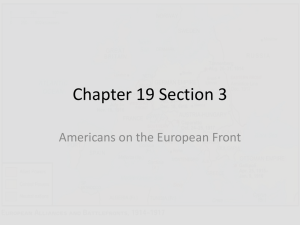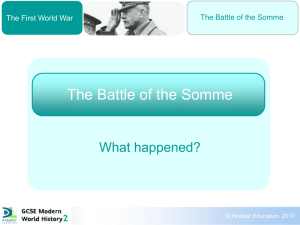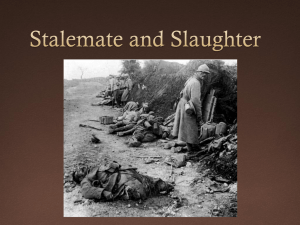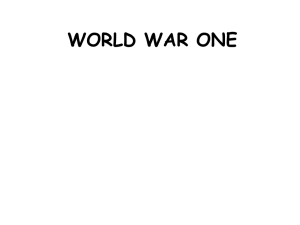World War One Non-Fiction - Pequannock Township Public Library
advertisement
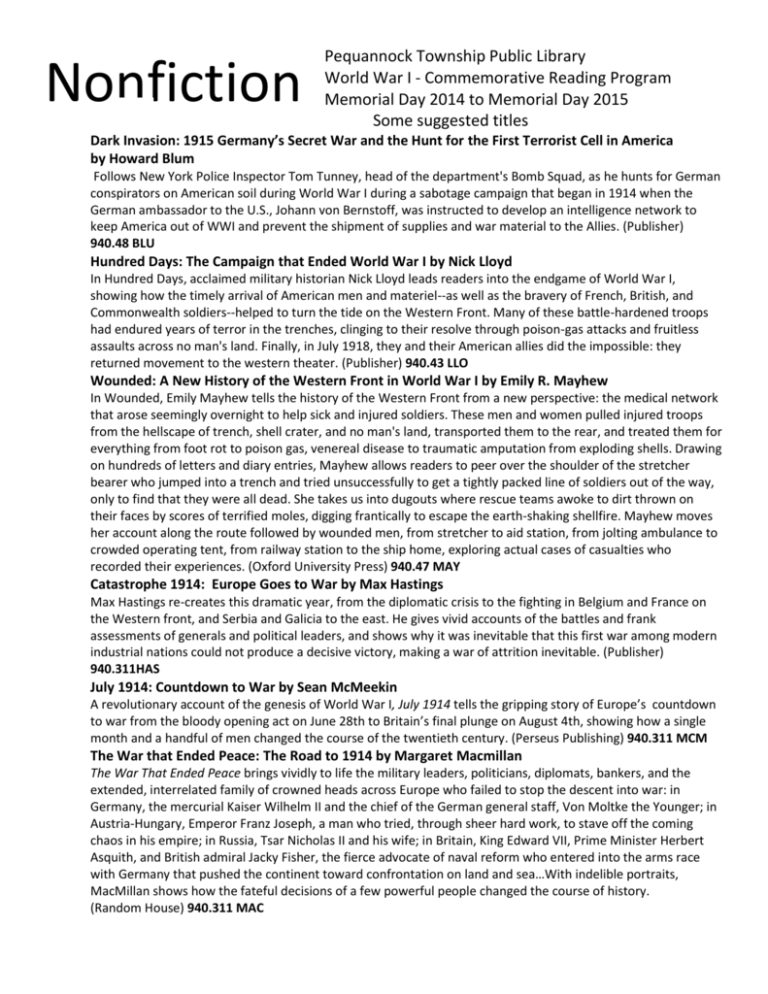
Nonfiction n Pequannock Township Public Library World War I - Commemorative Reading Program Memorial Day 2014 to Memorial Day 2015 Some suggested titles Dark Invasion: 1915 Germany’s Secret War and the Hunt for the First Terrorist Cell in America by Howard Blum Follows New York Police Inspector Tom Tunney, head of the department's Bomb Squad, as he hunts for German conspirators on American soil during World War I during a sabotage campaign that began in 1914 when the German ambassador to the U.S., Johann von Bernstoff, was instructed to develop an intelligence network to keep America out of WWI and prevent the shipment of supplies and war material to the Allies. (Publisher) 940.48 BLU Hundred Days: The Campaign that Ended World War I by Nick Lloyd In Hundred Days, acclaimed military historian Nick Lloyd leads readers into the endgame of World War I, showing how the timely arrival of American men and materiel--as well as the bravery of French, British, and Commonwealth soldiers--helped to turn the tide on the Western Front. Many of these battle-hardened troops had endured years of terror in the trenches, clinging to their resolve through poison-gas attacks and fruitless assaults across no man's land. Finally, in July 1918, they and their American allies did the impossible: they returned movement to the western theater. (Publisher) 940.43 LLO Wounded: A New History of the Western Front in World War I by Emily R. Mayhew In Wounded, Emily Mayhew tells the history of the Western Front from a new perspective: the medical network that arose seemingly overnight to help sick and injured soldiers. These men and women pulled injured troops from the hellscape of trench, shell crater, and no man's land, transported them to the rear, and treated them for everything from foot rot to poison gas, venereal disease to traumatic amputation from exploding shells. Drawing on hundreds of letters and diary entries, Mayhew allows readers to peer over the shoulder of the stretcher bearer who jumped into a trench and tried unsuccessfully to get a tightly packed line of soldiers out of the way, only to find that they were all dead. She takes us into dugouts where rescue teams awoke to dirt thrown on their faces by scores of terrified moles, digging frantically to escape the earth-shaking shellfire. Mayhew moves her account along the route followed by wounded men, from stretcher to aid station, from jolting ambulance to crowded operating tent, from railway station to the ship home, exploring actual cases of casualties who recorded their experiences. (Oxford University Press) 940.47 MAY Catastrophe 1914: Europe Goes to War by Max Hastings Max Hastings re-creates this dramatic year, from the diplomatic crisis to the fighting in Belgium and France on the Western front, and Serbia and Galicia to the east. He gives vivid accounts of the battles and frank assessments of generals and political leaders, and shows why it was inevitable that this first war among modern industrial nations could not produce a decisive victory, making a war of attrition inevitable. (Publisher) 940.311HAS July 1914: Countdown to War by Sean McMeekin A revolutionary account of the genesis of World War I, July 1914 tells the gripping story of Europe’s countdown to war from the bloody opening act on June 28th to Britain’s final plunge on August 4th, showing how a single month and a handful of men changed the course of the twentieth century. (Perseus Publishing) 940.311 MCM The War that Ended Peace: The Road to 1914 by Margaret Macmillan The War That Ended Peace brings vividly to life the military leaders, politicians, diplomats, bankers, and the extended, interrelated family of crowned heads across Europe who failed to stop the descent into war: in Germany, the mercurial Kaiser Wilhelm II and the chief of the German general staff, Von Moltke the Younger; in Austria-Hungary, Emperor Franz Joseph, a man who tried, through sheer hard work, to stave off the coming chaos in his empire; in Russia, Tsar Nicholas II and his wife; in Britain, King Edward VII, Prime Minister Herbert Asquith, and British admiral Jacky Fisher, the fierce advocate of naval reform who entered into the arms race with Germany that pushed the continent toward confrontation on land and sea…With indelible portraits, MacMillan shows how the fateful decisions of a few powerful people changed the course of history. (Random House) 940.311 MAC The Penguin Book of First World War Poetry Unrivaled in its range and intensity, the poetry of World War I continues to have a powerful effect on readers. This newly edited anthology reflects the diverse experiences of those who lived through the war, bringing together the words of poets, soldiers, and civilians affected by the conflict. Here are famous verses by Rupert Brooke, Siegfried Sassoon, and Wilfred Owen; poetry by women writing from the home front; and the anonymous lyrics of soldiers songs. Arranged thematically, the selections take the reader through the war’s stages, from conscription to its aftermath, and offer a blend of voices that is both unique and profoundly moving (Penguin Putnam) . 808.81 PEN The Guns of August by Barbara Tuchman In this landmark, Pulitzer Prize–winning account, renowned historian Barbara W. Tuchman re-creates the first month of World War I: thirty days in the summer of 1914 that determined the course of the conflict, the century, and ultimately our present world. Beginning with the funeral of Edward VII, Tuchman traces each step that led to the inevitable clash. And inevitable it was, with all sides plotting their war for a generation. Dizzyingly comprehensive and spectacularly portrayed with her famous talent for evoking the characters of the war’s key players, Tuchman’s magnum opus is a classic for the ages. (publisher) 940.3 TUC The Five Lieutenants: The Heartbreaking Story of Five Harvard Men Who Led America to Victory in World War I by James Carl Nelson Five Lieutenants tells the story of five young Harvard men who took up the call to arms in the spring of 1917 and met differing fates in the maelstrom of battle on the Western Front in 1918. Delving deep into the motivations, horrific experiences, and ultimate fates of this Harvard-educated quintet—and by extension of the brilliant young officer class that left its collegiate and post-collegiate pursuits to enlist in the Army and lead America’s roughand-ready doughboys—Five Lieutenants presents a unique, timeless, and fascinating account of citizen soldiers at war, and of the price these extraordinary men paid while earnestly giving all they had in an effort to end “the war to end all wars.”(MacMillan Palgrave) 940.4127 NEL To End All Wars: A Story of Loyalty and Rebellion, 1914-1918 by Adam Hochschild In a riveting, suspenseful narrative with haunting echoes for our own time, Adam Hochschild brings WWI to life as never before, focusing on the long-ignored moral drama of its critics, alongside its generals and heroes. A brilliant new history of the Great War that raises the eternal question of why such a terrible war was ever fought. 940.3 HOC The Beauty and the Sorrow by Peter Englund translated by Peter Graves In this masterly, highly original narrative history, Peter Englund takes a revelatory new approach to the history of World War I, magnifying its least examined, most stirring component: the experiences of the average man and woman—not only the tragedy and horror but also the absurdity and even, at times, the beauty. The twenty people from whose journals and letters Englund draws are from Belgium, Denmark, and France; Great Britain, Germany, and the Austro-Hungarian Empire; Italy, Australia, and New Zealand; Russia, Venezuela, and the United States. There is a young man in the British army infantry who had been considering emigrating until the war offered him its “grand promise of change” and a middle-aged French civil servant, a socialist and writer whose “faith simply crumbled” at the outbreak of war. There is an American woman married to a Polish aristocrat, living a life of quiet luxury when the war begins but who will be moved, ultimately, to declare: Looking Death in the eyes, one loses the fear of Him. From field surgeon to nurse to fighter pilot, some are on the Western Front, others in the Balkans, East Africa, Mesopotamia. Two will die, one will never hear a shot fired; some will become prisoners of war, others will be celebrated as heroes. But despite their various war-time occupations and fates, genders and nationalities, they will be united by their involvement—witting or otherwise— in The Great, and terrible, War. (Random House) 940.3 ENG With Our Backs to the Wall: Victory and Defeat in 1918 by David Stevenson Why did World War I end with a whimper—an arrangement between two weary opponents to suspend hostilities? Why did the Allies reject the option of advancing into Germany and taking Berlin? Most histories of the Great War focus on the avoidability of its beginning. This book focuses on Germany’s inconclusive defeat and its ominous ramifications. (Harvard University Press) 940.434 STE Elsie and Mairi Go To War: Two Extraordinary Women on the Western Front by Diane Atkinson In 1914, they roared off to London "to do their bit," and within a month they were in Belgium, right in the thick of things, driving ambulances from the frontlines to distant military hospitals. Frustrated by the number of men dying in the back of their vehicles en route to proper care, they decided to set up their own first-aid post on the front line in the village of Pervyse, near Ypres, risking their lives working under sniper fire, heavy bombardment, and horrific conditions for months at a time. As news of their courage and expertise spread, the "Angles of Pervyse" became celebrities, visited by journalists and photographers as well as royals and VIPs. (Blackwell Pub.) 940.47 ATK The Canvas Falcons by Stephen Longstreet Longstreet presents an extensive look at the planes and the men who were the pioneers of aerial combat. 940.4 LON The Last of the Doughboys: The Forgotten Generation and Their Forgotten World War by Richard Rubin In 2003, 85 years after the armistice, it took Richard Rubin months to find just one living American veteran of World War I. But then, he found another. And another. Eventually he managed to find dozens, aged 101 to 113, and interview them. All are gone now… They were the final survivors of the millions who made up the American Expeditionary Forces, nineteenth-century men and women living in the twenty-first century. Self-reliant, humble, and stoic, they kept their stories to themselves for a lifetime, then shared them at the last possible moment, so that they, and the World War they won – the trauma that created our modern world – might at last be remembered. You will never forget them. The Last of the Doughboys is more than simply a war story: It is a moving meditation on character, grace, aging, and memory. (Houghton) 940.41273 RUB Cannon Fodder by A. Stuart Dolden All the features of World War I that made up the ordinary soldiers’ lot are in this book. It is the story of A. Stuart Dolden, who served with pride in the ranks of the 1st Battalion London Scottish Regiment – the first British Territorial troops to go into battle in World War I and this book is based on a day-to-day diary kept by the author from his enlistment in 1914 to demobilization in 1919. 940.4144 DOL The Great War: July 1, 1916: the First Day of the Battle of the Somme: an Illustrated Panorama by Joe Sacco Launched on July 1, 1916, the Battle of the Somme has come to epitomize the madness of the First World War. Almost 20,000 British soldiers were killed and another 40,000 were wounded that first day, and there were more than one million casualties by the time the offensive halted. In The Great War, acclaimed cartoon journalist Joe Sacco depicts the events of that day in an extraordinary, 24-foot- long panorama: from General Douglas Haig and the massive artillery positions behind the trench lines to the legions of soldiers going“over the top”and getting cut down in no-man’s-land, to the tens of thousands of wounded soldiers retreating and the dead being buried en masse. The Great War is a landmark in Sacco’s illustrious career and allows us to see the War to End All Wars as we’ve never seen it before. - (WW Norton) 940.4272 SAC The Somme: The Darkest Hour on the Western Front by Peter Hart On July 1, 1916, the British Army launched the "Big Push" that was supposed to bring an end to the horrific stalemate on the Western Front between British, French and German forces. What resulted was one of the greatest single human catastrophes in twentieth century warfare: scrambling out of trenches in the face of German machine guns and artillery fire, the British lost over twenty thousand soldiers during the first day. This "battle" would drag on for another four bloody months.Expertly weaving together letters, diaries, and other first-person accounts, Peter Hart gives us a compelling narrative tribute to this infamous tragedy that epitomized the futility of "the war to end all wars." (WW Norton) 940.4272 HAR The Dardanelles Disaster: Winston Churchill’s Greatest Failure by Dan Van Der Vat With a narrative rich in human drama, The Dardanelles Disaster highlights all the diplomatic clashes from Whitehall to the Hellespont, Berlin to Constantinople, and St. Petersburg to the Bosporus. Van der Vat analyzes Churchill's response to the obstacles he faced and describes the fateful actions of the Turkish, German, and British governments. With never before published information on Colonel Geehl's minelaying operation, which won the battle for the Germans, The Dardanelles Disaster is essential reading for everyone interested in great naval history, Churchill's early career, and World War I. The repercussions of that battle are felt more strongly than ever today. (Penguin Putnam) 940.426 VAN Gallipoli: The End of the Myth by Robin Prior The Gallipoli campaign of 1915–16 was an ill-fated Allied attempt to shorten the war by eliminating Turkey, creating a Balkan alliance against the Central Powers, and securing a sea route to Russia. A failure in all respects, the operation ended in disaster, and the Allied forces suffered some 390,000 casualties. This conclusive book assesses the many myths that have emerged about Gallipoli and provides definitive answers to questions that have lingered about the operation. Robin Prior, a renowned military historian, proceeds step by step through the campaign, dealing with naval, military, and political matters and surveying the operations of all the armies involved: British, Anzac, French, Indian, and Turkish. Relying substantially on original documents, including neglected war diaries and technical military sources, Prior evaluates the strategy, the commanders, and the performance of soldiers on the ground. His conclusions are powerful and unsettling: the naval campaign was not “almost” won, and the land action was not bedeviled by “minor misfortunes.” Instead, the badly conceived Gallipoli campaign was doomed from the start. And even had it been successful, the operation would not have shortened the war by a single day. Despite their bravery, the Allied troops who fell at Gallipoli died in vain. (Yale University) 940.426 PRI Verdun: The Longest Battle of the Great War by Paul Jankowski At seven o'clock in the morning on February 21, 1916, the ground in northern France began to shake. For the next ten hours, twelve hundred German guns showered shells on a salient in French lines. The massive weight of explosives collapsed dugouts, obliterated trenches, severed communication wires, and drove men mad. As the barrage lifted, German troops moved forward, darting from shell crater to shell crater. The battle of Verdun had begun. (Oxford University Press) 940.4272 JAN The Marne: The Opening of World War I and the Battle that Changed the World by Holger H. Herwig It is one of the essential events of military history, a cataclysmic encounter that prevented a quick German victory in World War I and changed the course of two wars. This is a bold new account of the Battle of the Marne, giving, for the first time, all sides of the story. Military historian Holger H. Herwig reinterprets Germany's aggressive Schlieffen Plan as a carefully crafted design to avoid a protracted war against superior coalitions. He also provides cameos of the important players. In remarkabledetail, and with exclusive information based on newly unearthed documents, Herwig re-creates the dramatic battle, revealing how the uncoordinated German forces were foiled and years of brutal trench warfare were made inevitable.--From publisher description. (Baker & Taylor) 940.421 HER Miracle at Belleau Wood: The Birth of the Modern U.S. Marine Corps by Alan Axelrod By the time the Battle of Belleau Wood was over, Americans hailed it as "the Gettysburg of the Great War." Although it did not win World War I, it did rescue America and its allies from almost certain defeat, much as the Civil War's Gettysburg denied the Confederates victory. In June 1918, all that stood between the German army and Allied defeat was 200 United States Marines. But Belleau Wood was more than the salvation of the four-year Allied crusade to “make the world safe for democracy.” The battle, stunning in its concentration and intensity, was the fiery furnace from which the modern United States Marine Corps emerged as America's fiercest and most effective warriors, the world’s preeminent fighting elite. (Globe Fearon Co) 940.43 AXE The Englishman’s Daughter: A True Story of Love and Betrayal in World War I by Ben Macintyre In the first terrifying days of World War I, a handful of British soldiers found themselves trapped behind enemy lines on the Western Front. Unable to rejoin their units, which were retreating under the German onslaught, they were forced to hide in the French countryside. The Englishman's Daughter is the extraordinary true story of these men, their rescuers, and the bittersweet love affair that sprang up between an enchanting French villager and a fugitive English soldier. This romance flourished under the very eyes of German occupiers, resulted in the birth of a child, and eventually tore a community apart. - (Blackwell North Amer) 940.481 MAC

